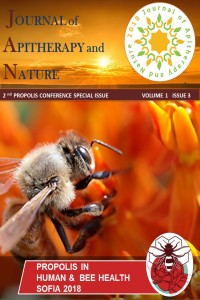Effect of Brazilian Propolis-containing Ointment on Genital Itching in Menopausal Women
Öz
Introduction:
Menopausal women can develop genital pruritus due to skin contraction and
drying associated with estrogen deficiency. The causes of pruritus include
contact dermatitis, fungal dermatitis, dry dermatitis, and others. A definite
cause often cannot be identified. Propolis has reported antibacterial,
antifungal, and antipruritic effects, and can inhibit histamine release.
Accordingly, application of a propolis-containing agent to the genital region
in menopausal women may treat many causes of pruritus.
Methods:
Postmenopausal women with genital pruritus were randomly divided into 3
treatment groups: Group A (n=9) was treated with a 1% Brazilian
propolis-containing ointment, Group B (n=6) with an antihistamine-containing
ointment, and Group C (control, n=5) with a Vaseline ointment. Each group
applied ointment to the vulva twice a day. After 14 days, improvement in
pruritus was quantified with the visual analog scale (VAS). The study protocol
was approved by the ethics committee of Akita University.
Results: The
average VAS score was 4.7 for Group A, 3.0 for Group B, and 9.5 for Group C.
There was a significant difference between Group C and the other 2 groups.
Conclusion: The 1%
Brazilian propolis-containing ointment may be not as effective as the antihistamine
ointment, but did have some antipruritic effect.
by Yamada Research Grant
Anahtar Kelimeler
Kaynakça
- .
Öz
Kaynakça
- .
Ayrıntılar
| Birincil Dil | İngilizce |
|---|---|
| Bölüm | 2nd Propolis Conference Special Issue |
| Yazarlar | |
| Yayımlanma Tarihi | 8 Aralık 2018 |
| Yayımlandığı Sayı | Yıl 2018 Cilt: 1 Sayı: 3 - 2nd Propolis Conference Special Issue |
Kaynak Göster
ASOS Index

